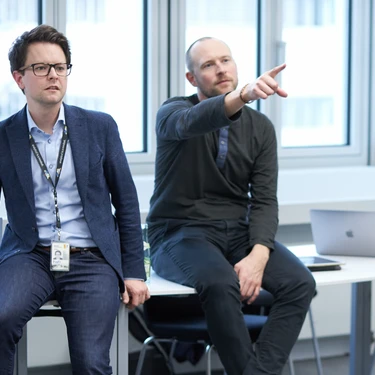Identifying the right start-ups is critical for successful collaboration. It is therefore crucial to think about and define clear processes and guidelines for choosing the most promising teams.
- Set the right focus
- Define search fields
- Find start-ups
- Evaluate start-ups
- Negotiate with start-ups
- Set the right focus
- Define search fields
- Find start-ups
- Evaluate start-ups
- Negotiate with start-ups
Set the right focus
The first step to finding the most suitable start-ups for collaboration is the definition of focus areas where the start-ups should be scouted. These focus areas can derive from company-specific challenges or from future-oriented topics, with the goal of exploring new market opportunities. The following aspects should be taken into consideration when setting the focus.
Exchange with the relevant internal business units
In house know-how can be used to identify relevant fields for potential start-up collaborations. In addition, experts from specialist departments can name concrete use cases that are suitable for implementation by start-up solutions. Another advantage is that potential project partners can be won for the implementation of the collaboration early on in the process.
Deduction from the corporate strategy
Some relevant questions are already addressed within an organisation (for example: interesting technologies or business models). However, caution is advised if focus areas are only based on strategic guidelines. This can lead to a lack of interest in the implementation of collaboration in the respective departments later on, and scouting approaches are thus lost in the void. It is therefore advisable to involve experts and specialist departments at the latest when validating the focus fields.
In addition to these two approaches, there are other sources of ideas for focus areas, such as opinion leaders and innovators in the company, a corporate venture capital unit, trend analyses or innovation departments.
Define search fields
Search fields give a structured overview of the criteria and topic areas according to which start-ups are to be scouted. They form an important basis for a corporate-internal common understanding of relevant start-ups.
The search field canvas provides an overview of the important criteria, based on our experience. In the following, we will describe each dimension of the canvas briefly.
Filling the search field canvas out together with relevant stakeholders can be a great exercise to kick-off start-up collaboration by considering multiple perspectives, requirements and expectations and thereby forming a common understanding. Once a first version of the search field is in place, feedback should be obtained from relevant stakeholders. In this way, different perspectives can be included in further iterations.
Scouting goals
First, sketch the solutions you are looking for. List specific solutions (e.g. “sensor fusion”), as well as abstract descriptions (e.g. “solutions that advance automated driving”). By following these steps, you avoid setting narrow limits which leave no room for unexpected and innovative solutions.
Relevant technologies
Next, the relevant technologies should be determined, but also those that are out of the question. In this way, the search can be made even more targeted.
General conditions
These criteria determine which basic requirements start-ups should meet, such as location, maturity of the start-up and development status of the solution.
Use cases
A use case describes the industry or field in which the solution is to be applied. A solution in a particular industry often brings specific requirements to the start-up. Predictive maintenance solutions, for example, are not transferable to every industry. In particularly innovative areas, however, other industries can be actively sought out for suitable solutions.
Examples
Last but not least, concrete examples of suitable start-ups should be listed in the canvas. They help to test the search field against real examples and to verify expectations for the concrete solutions. In addition, stakeholders can use examples to imagine the abstract topics.
Find Start-ups
Finding the right partner for a collaboration is not always easy, especially when it comes to start-ups which are still unknown.
We have identified the following three most promising ways for corporates to find the right start-up:
Search actively for an interesting start-up.
This requires a good overview of the relevant start-up scene and the scouting experience of young companies.
- Engage with external intermediaries such as entrepreneurship centres, scouting service providers and VC companies.
Start-ups often approach established companies directly – especially if the latter communicate their open attitude to collaborations publicly or even set up their own collaboration programs or corporate venture capital activities.
To foster this, corporates should transparently communicate information about the right contact points on their websites.
Team
- Is the team complementary, covering a broad range of skills (e.g., tech, marketing, business)?
- Does the team have prior experience in the industry?
- Does the team have prior experience at or with established companies?
- Is the team likeable? Can people in the established company imagine working closely with the team?
- Can the start-up commit (often scarce) resources to the collaboration?
This is especially important to consider for small teams, but also for fast-growing start-ups.
Strategic fit
- What problems will be solved or what opportunities can be realised by the collaboration? How big are they?
- Does the maturity level of the start-up/product fit the envisioned goals?
- Does the start-up product offer advantages over in-house development?
- How does the start-up benefit from the collaboration?
Motivation
- Can the start-up clearly demonstrate the added value that would result from the collaboration?
- Has the start-up engaged with the established company?
- Have the documents/presentations been adapted to the potential collaboration?
Product
- Is the value proposition communicated in a clear, attractive and catchy way?
- Is the technology convincing and does it fit with the established company?
- Has the start-up already been able to convince customers? Have there already been pilot projects with established companies (“Traction”)?
- Is the product developed to such an extent that it can really be tested in a relatively short period of time (in the form of a POC, also known as a pilot project)?
Financial KPIs
- Has the start-up already been able to convince investors?
- Is funding and/or revenue sufficient to keep the start-up in business in the coming months?
- How has the young company developed since its founding?
Internal support
- Are there departments in the company which are interested in collaborating with the start-up?
- Is there support from top management for the targeted use case?
Negotiate with start-ups
When the established company has found a start-up they would like to work with, negotiations about the set-up of the collaboration will commence. On the one hand, the concrete content, scope, timing and duration of the collaboration need to be defined. On the other hand, the general conditions, communication interfaces and profit distribution are also points to agree on. It is important to focus on creating a win-win situation for both partners.
Negotiations with start-ups are different than with established companies:
In discussions with founders, corporates must show transparency and be approachable to the young company. This also means accepting the time pressure of growing start-ups, as well as the deviation from usually very complex safety requirements, compensation regulations or other standards and demands. Complex and lengthy processes like purchasing or legal contracts can and should be adapted so that they are more start-up-friendly, e.g. quicker and less bureaucratic. However, companies should still require compliance from start-ups regarding certain things such as professional handling, clear communication and the agreement of milestones or targets. Only then can both sides work together successfully and trustfully!
Templates
Please feel free to download the following templates to do a final check of the chosen start-up:
Malek Chaabame, habemus!: Best Practices in Finding Startups
Malek Chaabane, Tunisian Branch Manager at German Mittelstand company habemus!, talks about what to look for when searching for and evaluating start-ups in Tunisia, but this is valid in any country.
Leveraging the UnternehmerTUM network to collaborate with Start-ups

Have a look back at step 2



